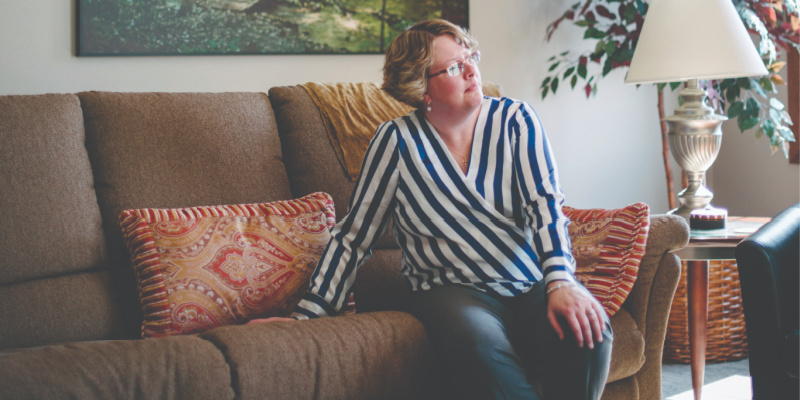By Katy Macek
Renee Zemke had just turned 39 and, after running her first Crazylegs Classic in 2016, she felt like she was in the “best shape of her life.”
Just a couple weeks later, on Mother’s Day weekend, her doctor told her she had invasive malignant melanoma.
Since then, Zemke, her husband and two young sons have been on a roller coaster of doctor’s visits, at-home shots, therapy and treatment. She’s hit her lowest lows, but the two things that kept her grounded were UW Health medical oncologist Mark Albertini, MD, and Gilda’s Club, a cancer support and education center for patients and their families.
“I sat here in this room with 12 people,” Zemke says on a sunny Wednesday afternoon at Gilda’s, in the room where she had her first group therapy session. “In the last 21⁄2 years, we’ve lost six of them. I don’t understand why I’m still here and they aren’t, so I work very hard to live with meaning.”
That new motto manifests primarily through partnering with Albertini to educate others on skin cancer, the most common cancer in the U.S.
Andrew Swanson, MD, specializes in Mohs and Dermatologic Surgery with UW’s School of Medicine and Public Health. He says our skin is made up of dozens of cells, any of which can potentially become cancerous, but the overwhelming majority lies in the top cells.
“This is probably because those areas are taking the brunt of damage to UV light exposure,” he says.
Squamous cell and basal cell are the most common types of skin cancer, Swanson says.
Melanoma is less common but is the deadliest because it’s more likely to spread if left untreated. The biggest risk factors for skin cancer are age, fair skin, tanning bed usage and sun exposure. Only those last two are in our control — and that’s where prevention has to focus.
“I remember being 16, 17, going in a tanning bed and laying out on Vilas beach with my girlfriends [with] no sunscreen,” Zemke says. “I can’t believe how stupid I was.”
LIVING WITH PURPOSE
While currently cancer-free, Zemke has accepted the grim odds of recurrence. She knows her life will never be the same, and — in some ways — that’s made her even more grateful.
“I never thought I would say this, but I am glad I got cancer,” she says. “Am I afraid to die? Absolutely. But, if my cancer comes back, I know I have Dr. Albertini and Gilda’s. I know I have support.”
Before cancer, Zemke says she, like many of us, had grand dreams. April 6 marked three years since she completed treatment, and her focus looks a little different now.
“Cancer really set me on my ass and forced me to understand life a little bit better,” she says. “It’s important to treat people with respect and have relationships that matter. At the end of the day, whose life did you make better?”
She uses her journey as a lesson. She was the keynote speaker for the 2018 UW Carbone Race for Research, where she shared her story and the importance of taking care of your skin.
“Now that I’m educated on melanoma, I look back at the mistakes I’ve made,” she says. “Now, I know better. Your skin is your largest organ. You’ve gotta take care of it.”
WHAT YOU CAN DO NOW TO PROTECT YOUR SKIN
UW Health dermatologist Andrew Swanson, MD, says most people are not getting the protection from sunscreen they think they are.
“In practical application, most people apply sunscreen far thinner than they need in order to get that (SPF) level of protection,” he says.
He suggests protective clothing such as broad-brimmed hats that cover your entire head, including ears, and lightweight long-sleeve shirts and pants.
The other important thing is skin checks, which he says are simple to do at home using just two mirrors — a full- length one in front of you and a hand mirror to see the back area. Use the ABCDE guidelines:
Asymmetry: Asymmetrical spots could be a sign of something more sinister than a freckle.
Borders: Irregular borders around the spot.
Color: Some combination of more than two colors — typically red, white or various shades of brown — is usually a warning sign.
Diameter: Is it larger than 6 millimeters?
Evolving: Does it change size or shape over time? This is the most important thing to note.
Check all areas of your skin, especially the backs of legs and back, where people tend to think less about sun protection.
If you have any concerning spots, get them checked by your doctor immediately.




